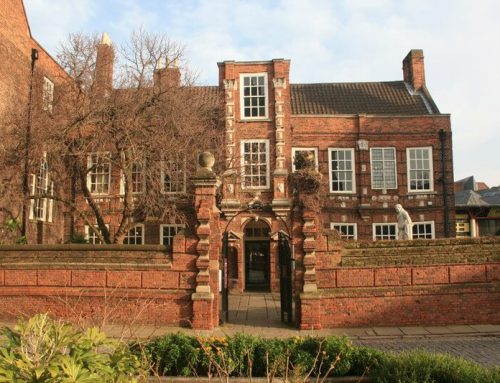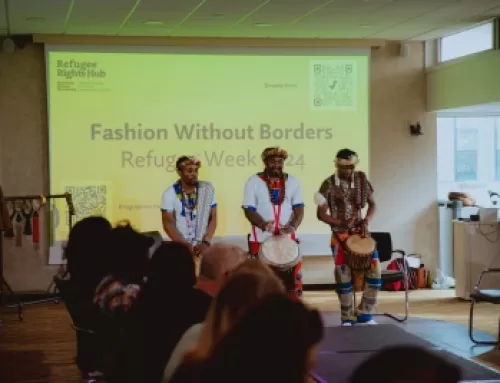This is the third in a series of blogs on the issue of habitual residence written by students from Binghamton University, whom the hub hosted in Summer 2024.
It was written by Jackie Schneider.
Is it morally or legally correct for refugees and asylum seekers to meet a broader test for habitual residence?
Question: Is there a definition of habitual residence in the Immigration Rules?
Introduction
In the Immigration Rules, the words ‘habitual residence’ are mentioned in three separate places: (1) Part 11: Asylum, (2) Appendix Family Reunion, and (3) Appendix Adoption. The latter, Appendix Adoption, refers to adoption requirements unrelated to asylum seekers and refugees. This blog addresses whether it is morally and legally correct for refugees and asylum seekers to meet a broader test for habitual residence, which both Part 11: Asylum and Appendix Family Reunion connect to.
Part 11: Asylum
Background In Part 11: Asylum, the first mention of habitual residence appears in Paragraph 339A, which discusses the requirements for the refugee convention to cease to apply to someone. In this paragraph, habitual residence describes a stateless person with no nationality. It says that the refugee convention ceases to apply to a stateless person with no nationality who can return to their country of former habitual residence because the reasons for which they fled to begin with no longer exist. In paragraph 339A, the Home Office covers people who voluntarily seek the protection of their country of nationality, people who lost their nationality and voluntarily reacquired it, and people who have a new nationality and enjoy the protection of that country. In this case, habitual residence is merely a placeholder used when a person has no nationality, meaning the Home Office sees a country of nationality or country of origin as equivalent to one’s habitual residence.
Analysis and Implications
By enforcing a higher standard of habitual residence for refugees and asylum seekers, the Home Office fails to consider that many refugees travel through multiple countries, even remaining in some of them for a lengthy period, before entering the UK. In Part 11, paragraph 352G also outlines that country of origin refers to the country of one’s nationality. For someone with no nationality, a stateless person, the country of their former habitual residence is what prevails. While the Immigration Rules do not delve further than paragraph 352G as to what exactly qualifies as someone’s former habitual residence, the Home Office implies that habitual residence refers to your country of origin and does not include a country where you traveled from, a country where you have set up residence, or a country where you have established a life for yourself over a prolonged period. This calls back to the question of whether it is morally and legally permissible to require refugees to meet a broader test for habitual residence, and it is not. Refugees travel through multiple countries before arriving in the UK; some even remain in those countries for a lengthy period before leaving because of the cost of travel, a method of transportation, and the cost of living; all of these factors can delay and even prevent someone from getting to the UK for a while. The time that many refugees might spend in another country, separate from their country of origin, can be enough time for them to establish a family, families that are invalid according to the Immigration Rules because those families did not originate from the refugee’s country of nationality, origin, or ‘habitual residence.’
Appendix Family Reunion
Background
Similarly, in Appendix Family Reunion, habitual residence is mentioned in the requirements an applicant must meet to join their sponsor in the UK. The Immigration Rules require that an applicant be part of the sponsor’s family, which was formed before the sponsor left the country of their habitual residence. Whether it be a child, a spouse, a partnership, or the applicant has lived with the sponsor for at least two years, it has to have happened in the country of their habitual residence. Appendix Family Reunion gives fewer details regarding the definition of a sponsor’s country of habitual residence. However, coupled with the earlier mentions in Part 11: Asylum, it can be inferred that the Home Office regards the sponsor’s habitual residence as the country of origin.
Conclusion
Analysis and Implications
In all three places in the Immigration Rules where habitual residence is mentioned, an exact definition of the term is not provided. The Home Office has placed extreme emphasis on the term and repeatedly uses it as a basis for denying applications. Yet, they fail to give an exact definition or distinction between a country someone originated from and a country where someone established a residence and a family. The failure to provide a precise definition leaves a broad range of interpretations that solicitors and applicants can submit to the Home Office in favor of their case. Still, it also allows a wide range of interpretations that the Home Office can use to deny any application based on habitual residence without providing an in-depth explanation.
Question: A Critical analysis of AA→does it still stand following the decision in ATIF?
Case Facts of AA
In 2004, the Immigration Appeal Tribunal heard AA, a case regarding paragraph 352A of the Immigration Rules. In this case, the sponsor was a Somolian national who fled Somalia and lived in Ethiopia from 1997-2000. In that time, she met and eventually married another Somalian national in 1999. She left Ethiopia in 2000 and traveled to the UK, where she claimed asylum and was given protection status. At the time of the decision, paragraph 352A required that the spouse of a refugee must (1) be married to a person granted asylum in the UK, (2) have been married before the person granted asylum left the country of their former habitual residence in order to seek asylum, (3) the applicant would not be excluded from protection if they were to seek asylum in their own right, and (4) if the applicant was seeking leave to enter, they would hold a valid UK entry clearance for that capacity. The main issue in AA whether the appellant has satisfied the requirements of 352A, specifically the second requirement, where his marriage had to take place before the sponsor left the country of her former habitual residence. The adjudicator in the case had previously ruled that the appellant did not satisfy the requirements because, in his opinion, the meaning of ‘former habitual residence’ referred to the country where the sponsor fled persecution to seek asylum. The adjudicator stated that because the marriage had occurred in Ethiopia, which was after the sponsor had fled Somalia, the appellant could not satisfy the requirements of 352A. The appellant’s solicitor emphasized that the adjudicator had used a narrow interpretation of the rule and failed to consider the rule’s original intent, which lies in the Final Act of the United Nations Conference on the Status of Refugees. This act encouraged the reunification of refugees and their families because the family unit was fundamental to society, and having that family unit was a given right to any refugee. The appellant’s solicitor also argued that prior cases, such as Gasmelsid and Qurash Shah, had established that the policies laid out in 352A had every intent to grant spouses and minor children of the sponsor entry into the UK as long as that family unit was formed before the sponsor was granted refugee status. All others who fall outside of this category, such as family established after the sponsor was granted status or family members who aren’t a spouse or child, would fall under other provisions of the Immigration Rules, not family reunion, and would have to adhere to different regulations and requirements.
Tribunal Rulings in AA
The Tribunal sees the policy as requiring the marriage to occur before the sponsor fled her country of habitual residence to seek asylum, which in this case would be Ethiopia. The sponsor fled Ethiopia, intending to claim asylum in the UK. She did not flee Somalia with the intention of claiming asylum in Ethiopia; she made no attempts to claim asylum or go through the formal process in Ethiopia. Her habitual residence, as viewed by the Appeals Tribunal, is Ethiopia, and given that her marriage occurred before fleeing Ethiopia, the Tribunal sees the marriage as valid. The Tribunal also notes that the Final Act Conference intended to encourage family reunification, not deter it and that there is a general understanding that refugees might establish a habitual residency in a third country that is separate from the country they fled and the country they wish to claim asylum in, just like the sponsor in this case did. They also made clear that, in their opinion, the wording “left the country of their formal habitual residence in order to seek asylum” is synonymous with saying “in order to make a claim for asylum.” In other words, the sponsor had to flee Somalia to make a claim for asylum in the UK. She did not travel to Ethiopia specifically to seek asylum in that country, but rather, she fled to Ethiopia because she knew a family there that she could live with, and in order to claim asylum in the UK, she would have needed to flee Somalia first. When the sponsor left Ethiopia, she did so because she was going to make a claim for asylum in the UK. Ethiopia became her habitual residence because that is the country she fled with the intent of making a claim for asylum. While the Appeals Tribunal did not declare an official interpretation of the meaning behind 352A’s provisions, they did leave a broader frame of interpretation for future cases, which the Upper Tribunal in ATIF disagreed with.
Case Facts of ATIF
ATIF was heard in 2017 by the Upper Tribunal regarding the denial of an application made by an Eritrean national to join his wife, who has protection status, in the UK. The sponsor fled Eritrea in 2002 and went to Sudan but did not claim asylum. She met the applicant in 2011 and married him in 2012. Two years later, she traveled to the UK and claimed asylum. She was granted status in 2015. Her husband applied to join her in the UK, but the application was denied because the marriage occurred after the sponsor left the country of her former habitual residence.
Tribunal Rulings in ATIF
Cited Sources
The Upper Tribunal ruled differently for three main reasons; the first is the cited sources on which they based their arguments. The Tribunal in AA had used case law and the Final Act Conference as the foundation for their decision. The Upper Tribunal disagreed with relying so heavily on the Final Act Conference and, instead, suggested that the provisions of 352A had small references to the Conference, but the provisions were less heavily influenced by the Conference than the Tribunal in AA believed them to be. Instead, they preferred to look at European legislation to understand the provisions of 352A properly. They referenced specific directives and regulations such as Article 2 of the Qualification Directive (2004/83/EC), Article 23, and Regulation 604/2013/EU Dublin III, which all define family units similarly. At the core of each regulation was the idea that the family unit of an applicant could be entitled to benefits as long as the unit existed in the applicant’s country of origin. No regulations or directives suggest that a family unit formed after the applicant leaves their country of origin should be entitled to the same benefits. They also argue that because applicants who qualify for family reunion are entitled to certain benefits, upholding the broad interpretation of 352A like AA did could lead to applicants remaining in third countries to establish families and delay their asylum claim because they know the Home Office is more likely to view that third country as their habitual residence and grant their family entry into the UK. The Upper Tribunal also refers to the definition of a refugee itself, based on Immigration law, implying that once the sponsor, in this case, fled Eritrea, she became a refugee because she was fleeing from persecution and that once she entered Sudan, she automatically claimed asylum in that country. The Upper Tribunal disagreed with AA, saying that there cannot be a third country in which a refugee resides that is separate from the country they fled and the country they intend to claim asylum. They believe that once you enter another country after fleeing persecution in your previous country, you are automatically making an asylum claim, regardless of whether you go through the formal process of an asylum claim or not. In the case of ATIF, the Upper Tribunal said that the sponsor was already a refugee the minute she fled Eritrea. The minute she entered Sudan, she made an asylum claim even though it was not formal or official. This meant that Eritrea was her former habitual residence because she fled that country to seek asylum in Sudan, and her marriage would have had to have taken place before she fled Eritrea, which it did not, which is why the Upper Tribunal held that the application for Family Reunion must be rejected. The Upper Tribunal held that European definitions and legislation were better fit to provide context behind the meaning of paragraph 352A rather than using the Final Act Convention’s original intentions. Tribunal Rulings in ATIF
The wording in paragraph 352A
The second biggest reason the Upper Tribunal differed on the rulings in AA was the wording of a particular clause in 352A. As stated earlier, the Immigration Appeal Tribunal in AA saw the second requirement in 352A “…left the country of their former habitual residence in order to seek asylum” as being the same as “in order to make a claim for asylum.” If that logic from AA were applied to the case in ATIF, it would mean that the sponsor fled Eritrea to claim asylum in the UK. She ended up in Sudan but made no effort to claim asylum, and she only left Eritrea so she could make an asylum claim in general, not because she was seeking asylum specifically in Sudan. When the sponsor left Sudan for the UK, that was when she was seeking specific asylum in the UK, which makes Sudan her former habitual residence. The Upper Tribunal disagreed with this and reapplied the logic, saying there is no difference in the phrasing and that “in order to seek asylum” is straightforward. The minute you flee persecution in your country, you become a refugee, and the minute you enter another country for safety, you have sought asylum in that country. It does not matter what country you intend to claim asylum in formally; the only thing that matters is that you fled your country to seek asylum, and the minute you do that, that country you fled becomes your former habitual residence.
Tribunal Rulings in ATIF
Intent
The last notable difference between the two cases is their overall intent. The intent of the Appeals Tribunal in AA was not to set an exact definition of habitual residence or interpret what 352A means precisely, but rather, they wanted to establish that the term itself was not made explicitly clear for a reason. The draftsman of 352A could have easily said country of origin or country of nationality or made clear precisely what habitual residence means, but they did not. Initially, the provisions of 352A even stated that a sponsor had to be married before leaving their country of nationality before it was eventually changed to habitual residence. This aligns with the idea that the Appeals Tribunal in AA and the Home Office wanted to leave room for interpretation so that future cases could make arguments on a case-by-case basis. A refugee’s journey is not similar to any other refugee’s journey; everyone goes through different circumstances and countries, and one’s habitual residence will be different for each case, which is why AA and the Home Office wanted to keep the definition broad. AA recognizes that a refugee can establish a former habitual residence in a third country that is separate from their country of origin and the country in which they intend to claim asylum. The intent behind ATIF was to limit how 352A can be interpreted. They are focused more on the literal meaning of the words. They believe that the interpretation in AA was too broad and could allow families of refugees to take advantage of the broad interpretation. The Upper Tribunal considers someone a refugee immediately after they flee persecution and considers them to have claimed asylum the minute they enter into any country after that. This sets a dangerous precedent that does not consider the tribulations a refugee faces in trying to travel to the UK. ATIF also needs to consider the intent behind the family unity program, which was supposed to encourage reunification rather than find any way to deter it from happening.
Analysis and Implications of AA and ATIF
On paper, the Home Office employs a broad interpretation so that every case is looked at individually rather than compared to previous cases. The Home Office allows immigration solicitors and applicants to argue their interpretation of habitual residence rather than adhere to an official interpretation. It would seem as though the Home Office is trying to be more lenient for reunification of refugees; however, in practice, they seem to act the opposite. The Home Office does not provide an exact definition, seemingly so that people can interpret habitual residence in whatever way they see fit, but they can also make their interpretation of habitual residence, which they use to consistently deny applications without any reasoning or extensive explanations.
Conclusion
Holding refugees and asylum seekers to a broader standard when it comes to habitual residence is immoral. Refugees and asylum seekers go through emotional and physical turmoil in fleeing from persecution. It is a journey that can take months and even years before they arrive in the country they intend to claim asylum in. While ATIF disagreed with the ruling in AA, it did not overrule AA. The Upper Tribunal agreed with the verdict in AA, saying that the reasoning was viable, but it was not mandatory to follow. The 1951 Final Act Convention made it clear that the family unit was a pillar of society, and it was the right of any refugee to have one. If anyone can go abroad, fall in love, marry, and then wish to bring their spouse and children to that country without having to meet extensive tests like the habitual residence test, why should it be a higher standard for refugees? There is a way to balance leniency with efficiency. The Home Office wants to balance allowing refugees to bring their families to the UK while maintaining efficient screening procedures so that not just anyone can enter the UK. However, the lack of clarity surrounding habitual residence allows the Home Office complete control to deny or accept a family reunion application without any logical consistency or explanations. It is morally and legally incorrect for the Home Office to wield such power and cheat its own system by keeping the definition of habitual residence broad so it can interpret it however it sees fit.








